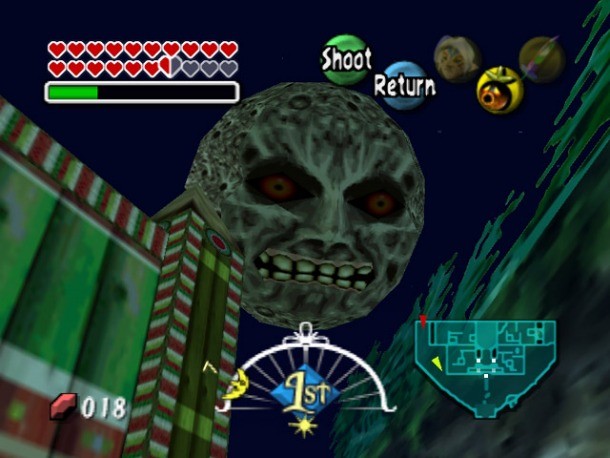Our extra-large special edition is here. Subscribe today and receive the 25% longer issue at no extra cost!
Zelda 25th Anniversary: Remembering Majora's Mask

Considering I had to wait six years between A Link to the Past and Ocarina of Time, the last thing I expected after the series’ 3D debut was a new console title within two years. I started hearing rumblings about a new Zelda in 1999, with the rumored titles Ura Zelda and Zelda: Gaiden. Screenshots depicted the young version of Link exploring a town with a large clock tower in the center, although further details were slow to release. More information leaked out during development, and I started to worry that the new game would be exclusive to the 64 DD (the failed N64 add-on that was never released outside of Japan). Being a 15 year-old who worked part-time at a movie theater, I definitely didn’t have the cash to spend on a bulky disc drive add-on, even if it was required to play Zelda. To my relief, Nintendo eventually announced that it would be coming to the Nintendo 64 proper, with the only additional purchase required being the relatively inexpensive Expansion Pak. When it finally released in late 2000, I expected a quickly made sequel to one of the best games of all time. What I got was a fantastic yet odd experience that stands as a unique departure in the Zelda franchise.
The most defining characteristic of Majora’s Mask is the way the story and time-bending gameplay mechanics work together. An ominous, gigantic moon (complete with demonic face) is looming over the land of Termina, and it threatens to take out the bustling Clock Town in three days. Link is tasked with enlisting the help of four giants to repel the moon, using the powers of the Ocarina to juggle time as needed.
Using familiar tunes like the “Song of Time” as well as a handful of new ones, Link could slow down or speed up time, as well as return to the first of the three days. With only a handful of major dungeons, most of Majora’s puzzles revolved around the residents of Termina. With his notebook, Link could track the needs and schedules of numerous characters, and significant rewards were in place for completing these sidequests.
These rewards usually came in the form of one of 24 magic masks. These ranged from bunny ears that made you run faster, to a mummy mask that made Redeads dance, to a Clockwork Orange-esque contraption that kept Link’s eyes open while an old woman told him boring stories. They weren’t all trivial, however. The Blast Mask let you create as many explosions as you wanted without having to waste a single bomb. The form-changing Zora, Goron, and Deku masks may have had a bigger impact on the overall gameplay, but discovering the uses of the more minor masks was just as much fun. While getting 100% in most modern games might snag you a hefty achievement, collecting all of the masks rewarded you with something that offered major in-game benefits. Taking bosses down as Link’s Fierce Deity form was a great way to feel powerful after all your hard work, and it’s one of the most impressive versions of Link we’ve seen in the series’ history.
When I think back to Majora’s Mask, my most immediate memory is that of the moon. It wasn’t just some timer on the HUD or a repeated reminder from your fairy; it was an omnipresent menace that would become immediately apparent by simply looking at the sky. This constant race against time was a novel gameplay mechanic, but it also served as one of the most stressful features in any game I’ve ever played. I spent hours exploring Hyrule Field at my leisure in Ocarina of Time. In Majora’s Mask, I felt like I was constantly running for my life.
As a follow-up to the iconic Ocarina of Time, Majora’s Mask took some huge risks with its dramatic gameplay shifts. Some gamers found the time mechanic too confusing or stressful, while others were fascinated with the new experiences it created (I consider myself in the latter camp). While it departed from the norm by featuring a tale that didn’t focus on Hyrule or Ganon, it still managed to include many familiar elements like Epona, a fairy companion, and the legendary overworld theme. These reminded you that you were certainly playing Zelda, but the rest of the game ensured it was unlike anything you had seen before.
For more Zelda memories from the Game Informer staff, check out our Zelda feed.
This essay originally appeared in Game Informer issue #222

Get the Game Informer Print Edition!
Explore your favorite games in premium print format, delivered to your door.
- 10 issues per year
- Only $4.80 per issue
- Full digital magazine archive access
- Since 1991









